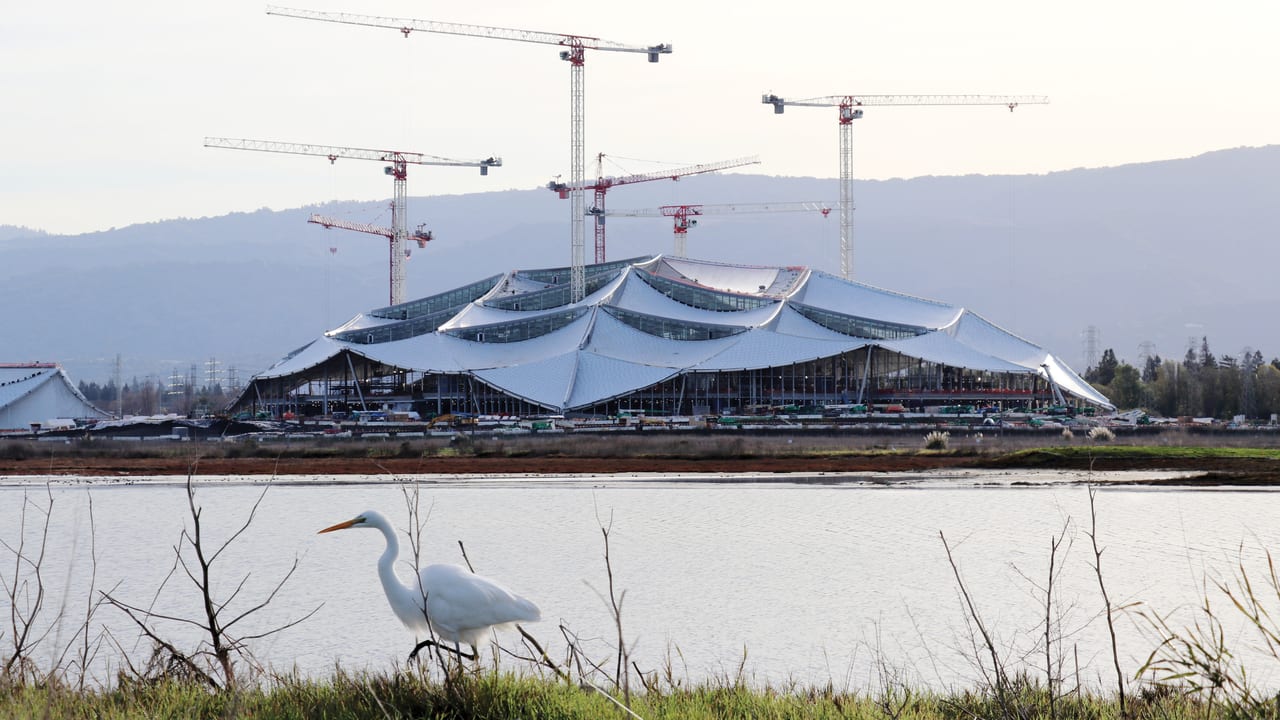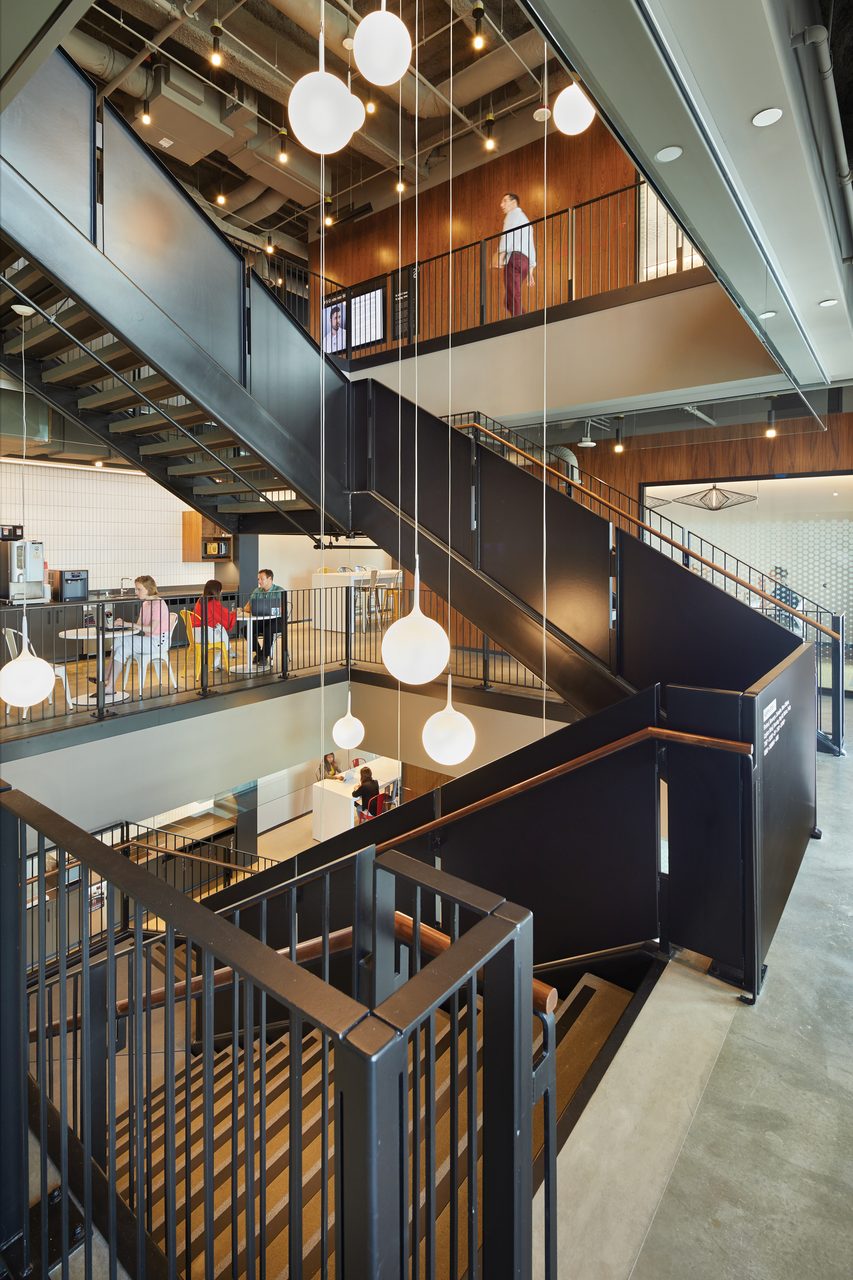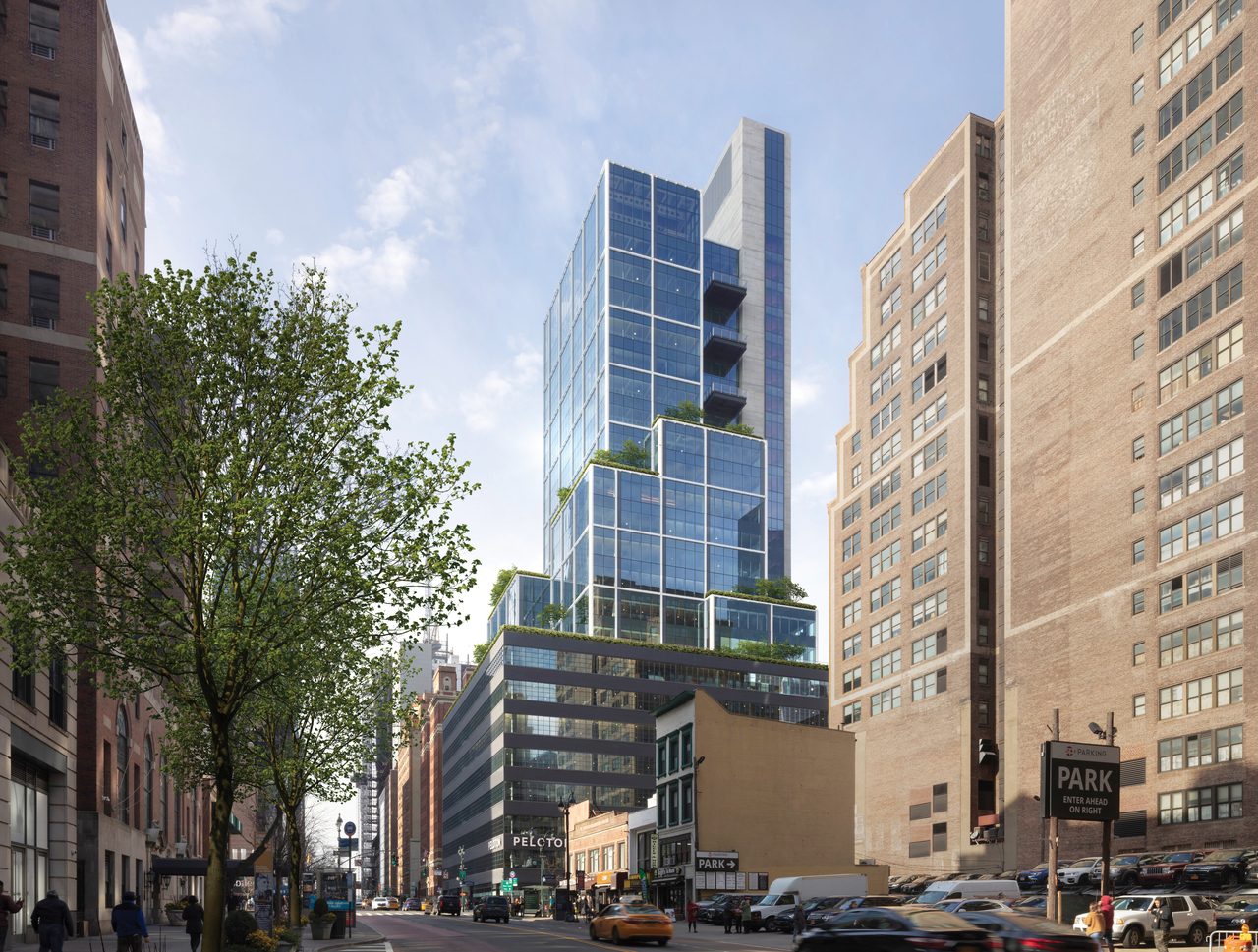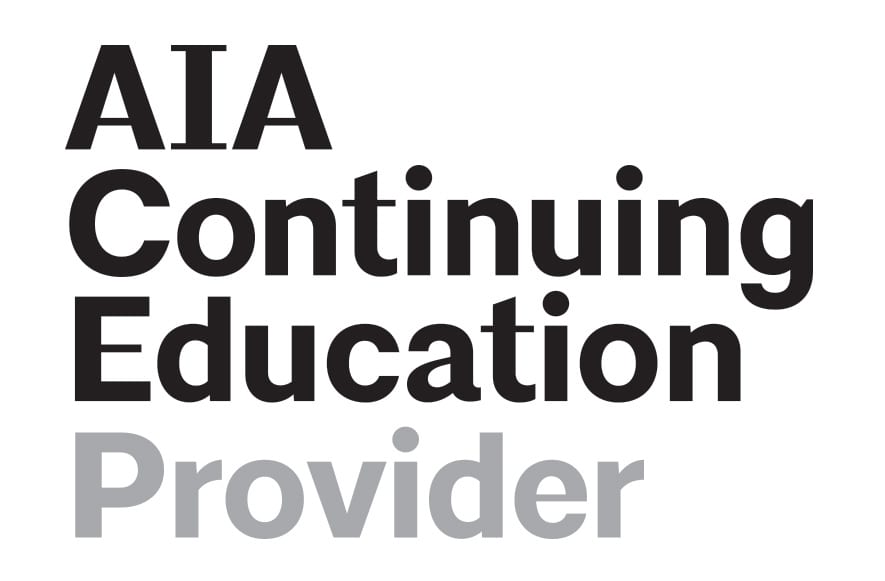DESIGNING HEALTHIER ENVIRONMENTS
Research can guide architects in designing for flexibility and creativity
By James S. Russell, FAIA
Rethinking the Office

The Post-Covid Workplace
For software company Atlassian, in Sydney, SHoP has designed a tower (right) with multistory “neighborhoods” that rise from gardens.
IMAGEs: © SHOP ARCHITECTS
There’s a lot of prognostication about the future workplace as the Covid pandemic has begun to retreat and more people are vaccinated. Organizations are examining whether their business needs demand a full return to office work, or whether they should become a fully virtual organization—given the success of remote work over the last 15 months—or whether they should deploy a hybrid strategy.
The tech giant Microsoft—heavily invested in effective computer-based work since the 1980s—has some answers, at least from the employee perspective. The company commissioned extensive workplace surveys during the pandemic, analyzing the experiences of its 160,000 global employees, and integrated the findings with research derived from a wide range of other industries. The New Future of Work project informs the company’s approach to Teams, its virtual-meetings app that competes with the ubiquitous Zoom, as well as new products it is rolling out. It has also made this research public, and is applying the intelligence to the ambitious rebuilding of its own Redmond, Washington, campus headquarters.
The key findings can help inform the design or redesign of the physical office, as companies plan a return to at least some in-person work. The Microsoft research supports a shift toward hybrid work, a choice the company itself has embraced. For example, in a survey of its offices in China—where buildings reopened fairly early in the pandemic—69 percent said they preferred a hybrid work model that includes a return to the office, but not a requirement that people come in every day. Only 19 percent wanted fully remote work, and only 11 percent thought everyone needed to be in the office.

Tentlike roofs shelter Google’s headquarters in Mountain View, California, by BIG and Heath-er-wick Studio.
PHOTOGRAPHY: © ChristoPHER McANNENY
Remote work, the research confirmed, presents a range of barriers for many staffers, from burnout to emotional stress and isolation. Team-based collaborative projects and creative work suffers. People miss the camaraderie of the office. Managers fear the loss of ideas generated by casual meetings and informal encounters that many office designs have fostered with numerous informal gathering areas. When record asked some architects what they are hearing from clients and how they are adapting their own workspaces, their guiding ideas happened to align with many of Microsoft’s findings.
Indeed, firms that adamantly resisted any remote work or meeting via videoconference before Covid have become converts. Working from home is popular among people who want to trade the headaches of commuting for more time with their families, a consensus supported by Microsoft’s research. Many noted that concentrated work was easier with fewer office interruptions—and they liked avoiding annoying coworkers.
But as the limitations of remote work have become all too evident, companies that once suggested people work permanently from home are now encouraging—or insisting—that their staffs return to the office. Besides isolation, the Microsoft researchers found that many people struggled with fatigue and mental health issues at home, while self-reporting about productivity by those working from home was inconclusive: respondents were evenly split among those who assessed themselves as more productive and satisfied outside the office and those who reported no difference or felt less satisfied and productive. As many of us know from our own experience, many found themselves working longer hours to keep up.
Notably, women reported working through the evening to make up for time lost to parenting and household obligations, with such long days contributing to increased tensions. In one survey, 85 percent of women and 70 percent of men with childcare responsibilities fell behind in completing work tasks.
One serious deficit of remote work concerned new hires, who lacked the informal help of colleagues in getting to know people and adapting to the company culture. Man-agers were challenged in making sure everyone they supervised was engaged and connecting to colleagues; but at the same time, women and younger employees, as well as Black employees and others from under-represented groups, feared being overlooked for promotions because they had fewer opportunities to demonstrate their skills and talents.
Days filled with videoconferencing are extremely fatiguing, and productive disagreements were hindered by an inability to perceive body language and to gauge emotions, the researchers concluded. While companies have tried to help people connect informally with virtual happy hours, there is as yet no app that replaces gathering around the water cooler.
In order to address some of the problems associated with virtual meetings, Microsoft has also begun to roll out “Teams rooms”—spaces in its offices that optimize interaction with an upgraded versions of its Teams app. They are intended to bring greater equity for those connecting remotely with others who are physically gathered in a meeting room.
But perhaps the biggest issue that has emerged is the hindrance to creativity and brainstorming of working remotely. Teams involved in the generation of new ideas suffered in spite of the array of virtual collaboration technology, according to the research. Those working on demanding projects missed the emotional bonds that can form, and team members “fell out of synch” with each other.
These findings are echoed in what tech companies are telling their architects. New York–based SHoP Architects’ tech clients are bringing people back to their physical locations, because “the degree to which you need people in the office has to do with how much ideation, creativity, and innovation is happening,” says Chris Sharples, a principal. “If you don’t have a lot of creative work going on”—he names insurance companies as an example—“you don’t need everyone in one place.”

Though many businesses are bringing staff back to offices by early fall, architects aren’t reporting wholesale redesigns to accommodate the post-Covid workplace yet, since uncertainties still abound. A rapid decline in social-distancing and mask requirements has organizations considering the end of plexiglass partitions and distanced seating. And the HVAC upgrades that a few months ago seemed essential may not be. But holdover Covid requirements may remain in place, since some jurisdictions may not permit vaccination mandates for workers. In talking with clients—especially about projects already designed but not yet built—architects are finding a change of emphasis, if not a dramatic rethinking.
In the workplace surveys, people looked to the office for everything from access to IT support to camaraderie with colleagues. So architects are asking, “What can the office provide that you can’t get at home?” as Ryan Mullenix, co-leader of NBBJ’s workplace-design practice in Seattle, puts it. Since creative and collaborative work is better in person, architects are doubling down on settings that allow informal teamwork. “We have been thinking about a hotel lobby metaphor,” says Sharples. “You encounter lounge seating, a place to huddle with your team, and pinup areas.”
A stair ascends through the 25 floors of NBBJ’s offices for F5 Networks in Seattle.
Architects also can help companies understand the sociology of working together and using design to support the company’s culture. The Microsoft researchers wrote that workspaces can encourage the development of “weak ties,” the large networks that people build with casual or occasional interactions outside their core group of colleagues. Some company cultures support these expansive networks because acquaintances become a source of ideas and problem-solving expertise.
Thus, places that ease such interaction—from stair-landing lounges and small breakout spaces next to conference rooms to coffee bars and fitness centers—are becoming part of the architect’s brief. In a 44-story Seattle tower, as part of a tenant fitout project, NBBJ included an attractive stairway that opens to skyline views as it ascends through the 25 floors occupied by F5 Networks, an app-support and security company. Most elevators stop every fourth floor, encouraging people to use the stairs, where they can have serendipitous encounters and look into various team areas along the way. “You never know when the Eureka moments will happen,” says NBBJ’s Mullenix. “Rarely does anyone go to a conference room to innovate.”
With so many people reporting stress, anxiety, and emotional exhaustion, architects are enhancing their client’s spaces with more daylight, fresh air, greenery, and, where possible, views of nature. “Before the pandemic, we were hearing from tech clients about the importance of access to outdoors,” says James von Klemperer, president of KPF. “Now outdoor space is a priority for the whole real-estate brokerage community.” He cites the success of his firm’s Hudson Commons project in Manhattan, which mounted a tower with lushly planted setbacks and balconies to an older warehouse building. That amenity was key to attracting the fitness-machine-maker Peloton as a major tenant, he adds.
NBBJ designed a complex for REI, the outdoor-equipment retailer, in Bellevue, Washington, around a connection to nature, with garden courtyards, green roofs, windowed stairs, and a vegetable garden. Largely completed last year, the strategy made sense for a company whose customers camp and climb mountains. Much of this outdoor space is shared with the public. “Employees who need to be in the office also get to be outside,” says Mullenix. “Brains are hungry for the unexpected, people-watching, zoning out.” The variety of settings also serves collaborating teams and fosters casual encounters. Yet REI, fearing Covid losses, sold the building, before ever occupying it, to Facebook, which liked its amenities and was expanding its Seattle-area presence.
Meanwhile, SHoP was designing, during Covid, the 40-story headquarters for software company Atlassian in Sydney, which pointedly blurs the boundaries between outside and inside. Within an operable glass facade, supported by an exterior tubular-steel diagrid, multi-floor “villages,” framed in mass timber, rise from gardens. “In these ‘between spaces,’ we forge natural connections with daylight and vegetation,” Sharples says. “The building begins to breathe.” Such healthful environments, with an abundance of fresh air, send a message about a company’s commitment to its staff’s well-being.

On Manhattan’s far west side, KPF added a tower with planted setbacks to an existing warehouse building.
PHOTOGRAPHY: © H.G. Esch
Sharples offers ideas for existing buildings, even those in dense cities with deep floorplates and narrow windows facing dim alleys, as well as those in suburban office parks that too often subject tenants to vistas of parked cars. “Such buildings need to be adapted,” he says. “By reducing the floor plate, bringing vegetation inside, and maximizing daylight.” When all else fails, he says, advanced lighting technology can aid mental and physical health, changing across the day to support human circadian rhythms.
“The office has to be an attractive place to go,” says Florencia Kratsman, the global director of space planning for the firm BIG. “You have to do everything better, both focused work and collaboration.” As Google rethinks the way it wants to use its facilities, Kratsman expects a “comfortable transition” into three new buildings that BIG and Heather-wick Studio planned several years ago because, already, “we were very focused on health, biophilia, and sustainability,” she explains. “These projects were so large that the design had to be broken down into neighborhoods”—a scale that virus-fearing workers can find reassuring. Under monumental tentlike roofs that accommodate clerestories, natural light will be widely accessible. “There are multiple access points, and multiple vertical cores, she added, “with their own coffee machines, their own courtyards, and meeting rooms aligned with groups”—all tactics that can aid group solidarity and help people feel safe in the post-Covid workplace. Given the benign climate in Mountain View, California, where these buildings are nearing completion, “outdoor spaces conceived as amenity spaces will shift to working spaces post-Covid,” she notes.
With childcare a prominent source of stress for remote workers, Kratsman is also urging companies to consider on-site day care, a relative rarity in the U.S. Parents may feel more productive returning to the office if they can have ready contact with their children. “Every workplace that we are doing in Europe and in Latin countries has a childcare component,” Kratsman observes. When European companies ask what their American counterparts do for workplace childcare, she has to answer “nothing.”
What about Microsoft, now in command of such key data about its own workers? Covid and the research came after construction had begun on an overhaul of its 520-acre Red-mond campus, an initial phase to replace 14 buildings and add three more, increasing its workspace by 2.5 million square feet and adding 500,000 square feet of amenities. The new buildings are grouped around outdoor space into the company’s own version of “villages,” with design commissions divvied among four architects: NBBJ, LMN, ZGF, and WRNS.
Microsoft has altered some of the spaces within the buildings to recognize its new hybrid work style, “providing a more agile workplace that removes barriers between on-site workers and their remote colleagues,” according to the company. In addition to its new Teams-rooms technology, it has also added app-based solutions that allow staff to verify vaccination status, guide on-site workers to meeting rooms, and book a desk space for the day. These new “location-management capabilities” will enable managers to monitor and control occupancy should a new need to minimize virus movement arise.
“According to our research, the vast majority of employees say they want more flexible remote-work options,” writes Satya Nadella, Microsoft’s CEO, in a blogpost published this spring. “They also say they want more in-person collaboration, post-pandemic.” The results reflect the aspirations for a new workplace model that offers the opportunity to innovate and work together, whether in an office shared with colleagues or remotely at home, with maximum efficiency and capacity to create. The company continues to work to reconcile what Nadella calls the “hybrid-work paradox.”
Continuing Education
To earn one AIA learning unit (LU), including one hour of health, safety, and welfare (HSW) credit, read “Rethinking the Office,” review the supplemental material found at architecturalrecord.com, and complete the quiz at continuingeducation.bnpmedia.com. Upon passing the test, you will receive a certificate of completion, and your credit will be automatically reported to the AIA. Additional information regarding credit-reporting and continuing-education requirements can be found at continuingeducation.bnpmedia.com.
Learning Objectives
- Describe the post-Covid spectrum of office work, including work from home, full return to the office, and hybrid arrangements.
- Explain the limitations of remote work uncovered by research.
- Identify design tactics that can attract remote workers back to office settings.
- Explain how office design can support collaborative, creative work.
AIA/CES Course #K2107A
